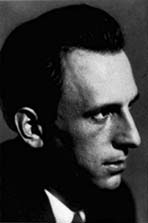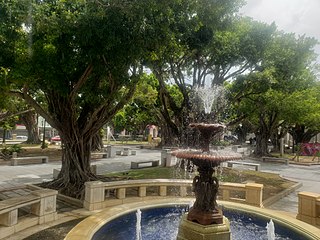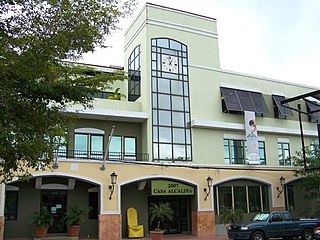Rubén Ángel Berríos Martínez is a Puerto Rican politician, international law attorney, writer, and current president of the Puerto Rican Independence Party (PIP). A former three-time senator, Berríos is a perennial PIP candidate for Governor of Puerto Rico. He led the Navy–Culebra protests that succeeded in the United States Navy abandoning the use of the Puerto Rican island of Culebra for military exercises and was a leader for the Cause of Vieques.

Mayagüez is a city and the eighth-largest municipality in Puerto Rico. It was founded as Pueblo de Nuestra Señora de la Candelaria de Mayagüez, and is also known as La Sultana del Oeste, Ciudad de las Aguas Puras, or Ciudad del Mangó. On April 6, 1894, the Spanish Crown granted it the formal title of Excelente Ciudad de Mayagüez. Mayagüez is located in the center of the western coast on the island of Puerto Rico. It has a population of 73,077 in the city proper, and it is a principal city of the Mayagüez Metropolitan Statistical Area and the Mayagüez–San Germán–Cabo Rojo Combined Statistical Area.

Lares is a mountain town and municipality of Puerto Rico's central-western area. Lares is located north of Maricao and Yauco; south of Camuy, east of San Sebastián and Las Marias; and west of Hatillo, Utuado and Adjuntas. Lares is spread over 10 barrios and Lares Pueblo. It is part of the Aguadilla-Isabela-San Sebastián Metropolitan Statistical Area.

The following is an alphabetical list of articles related to the Commonwealth of Puerto Rico.

Heinrich Klumb was a German architect who worked in Puerto Rico during the mid 20th Century.
Rafael Picó Santiago was one of Governor Luis Muñoz Marín's closest advisors. He served as the first chairman of the Puerto Rico Planning Board, President of the Government Development Bank for Puerto Rico, and served from 1965 to 1968 as a member of the Puerto Rico Senate elected by Muñoz' Popular Democratic Party (PDP).
The Colegio Cristo Rey is a Jesuit elementary and secondary school located in the city of Asunción, Paraguay. It was founded in 1938.

Caimito is one of the 18 barrios of the municipality of San Juan, Puerto Rico located in the mountainous part of the municipality. With a land area of 5.41 square miles (14.0 km2), Caimito is the second largest barrio in the municipality of San Juan, Puerto Rico. In 2010 it had 21,825 inhabitants and a population density of 4,034.2 per sq.mi. Located in the southern part of San Juan, Caimito is bordered by barrios Tortugo and Quebrada Arenas to the west, by Monacillo to the north, by Cupey to the east and by the municipality of Caguas to the south.
The University High School, commonly referred to by its initials "UHS", in San Juan, Puerto Rico is a college preparatory laboratory high school operated by the Faculty of Education of the University of Puerto Rico. Located on the University of Puerto Rico, Río Piedras Campus, it provides education to approximately 514 students from 7th to 12th grade.

Cataño barrio-pueblo is an urban barrio and the administrative center (seat) of Cataño, a municipality of Puerto Rico. Its population in 2010 was 4,283. It is an urban barrio located in the northeastern section of the municipality.

Naranjito barrio-pueblo is a barrio and the administrative center (seat) of Naranjito, a municipality of Puerto Rico. Its population in 2010 was 1,157.
Rafael Carmoega Morales (1894–1968) was a Puerto Rican architect from Rio Piedras, Puerto Rico. He was the first Puerto Rican to become State Architect, a position within the Department of the Interior which he held from 1921 to 1936. Carmoega was one of the most accomplished Puerto Rican architects of the 20th century.

Fernando Martín García is a Puerto Rican politician and former senator. He was a member of the Senate of Puerto Rico from 1989 to 1993, and then from 2000 to 2004.

St. Ignatius College, Santiago is a private Catholic primary and secondary school, located in Santiago, Chile. The school was founded by the Society of Jesus in 1856 and is run by the Jesuit St. Ignatius Foundation as a part of the Ignatian Educational Network of Chile, the Latin American Federation of Jesuit Colleges, and the Latin American Federation of the Society of Jesus (FLACSI).

Fernando Picó Bauermeister, S.J. was a Puerto Rican Jesuit, historian and academic. Picó was a leading expert on the history of Puerto Rico and was considered an authority on the island's 20th century history. One of his best known works, Historia General de Puerto Rico, is widely utilized in Puerto Rican history curricula. He was a professor of history at the University of Puerto Rico, Río Piedras Campus, from 1972 until his death in 2017.

Arroyo barrio-pueblo is a barrio and the administrative center (seat) of Arroyo, a municipality of Puerto Rico. Its population in 2010 was 1,206.

Guánica barrio-pueblo is a barrio and the administrative center (seat) of Guánica, a municipality of Puerto Rico. Its population in 2010 was 3,514.

Humacao barrio-pueblo is a barrio and the administrative center (seat) of Humacao, a municipality of Puerto Rico. Its population in 2010 was 3,862.

Vega Alta barrio-pueblo is a barrio and the administrative center (seat) of Vega Alta, a municipality of Puerto Rico. Its population in 2010 was 1,169.

Rincón barrio-pueblo is a barrio-pueblo, the administrative center (seat) of Rincón, a municipality of Puerto Rico. Its population in 2010 was 933.
















